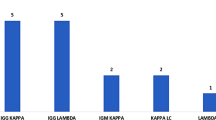Abstract
Monoclonal gammopathy of renal significance (MGRS) is a pathological state which presents with a spectrum of renal lesions. MGRS is characterized by pathogenic monoclonal immunoglobulins or light chains produced by a premalignant plasma cell or B cell clone. In view of inadequate understanding in the past, the low detection rate of MGRS often results in poor outcomes and reduces quality of life of patients. Thus, MGRS stands for a group of clinical refractory renal diseases. To date, no standard treatment strategy for MGRS is available. Current consensus suggests a clone-directed approach that aims to eradicate the offending clone, but its long-term prognosis is not clear. In this article, we discuss the diagnostic methods, highlight treatment advances, and introduce integrated Chinese and Western medicine in the management of MGRS.
Similar content being viewed by others
References
Kyle RA. Monoclonal gammopathy of undetermined significance. Natural history in 241 cases. Am J Med 1978;64:814–826.
Leung N, Bridoux F, Hutchison CA, Nasr SH, Cockwell P, Fermand JP, et al. Monoclonal gammopathy of renal significance: when MGUS is no longer undetermined or insignificant. Blood 2012;120:4292–4295.
Fermand JP, Bridoux F, Kyle RA, Kastritis E, Weiss BM, Cook MA, et al. How I treat monoclonal gammopathy of renal significance (MGRS). Blood 2013;122:3583–3590.
Bridoux F, Leung N, Hutchison CA, Touchard G, Sethi S, Fermand JP, et al. Diagnosis of monoclonal gammopathy of renal significance. Kidney Int 2015;87:698–711.
Leung N, Bridoux F, Batuman V, Chaidos A, Cockwell P, D’Agati VD, et al. Publisher correction: The evaluation of monoclonal gammopathy of renal significance: a consensus report of the International Kidney and Monoclonal Gammopathy Research Group. Nat Rev Nephrol 2019;15:45–59.
Ciocchini M, Arbelbide J, Musso CG. Monoclonal gammopathy of renal signifcance (MGRS): the characteristics and significance of a new meta-entity. Int Urol Nephrol 2017;49:2171–2175.
Steiner N, Göbel G, Suchecki P, Prokop W, Neuwirt H, Gunsilius E. Monoclonal gammopathy of renal significance (MGRS) increases the risk for progression to multiple myeloma: an observational study of 2935 MGUS patients. Oncotarget 2018;9:2344–2356.
Khera A, Panitsas F, Djebbari F, Kimberger K, Stern S, Quinn J, et al. Long term outcomes in monoclonal gammopathy of renal significance. Br J Haematol 2019;186:706–716.
Peña C, Schutz NP, Riva E, Valjalo R, Majlis A, López-Vidal H, et al. Epidemiological and clinical characteristics and outcome of monoclonal gammopathy of renal significance (MGRS)-related lesions in Latin America. Nephrology (Carlton) 2020;25:442–449.
Jain A, Haynes R, Kothari J, Khera A, Soares M, Ramasamy K. Pathophysiology and management of monoclonal gammopathy of renal significance. Blood Adv 2019;3:2409–2423.
Herrera GA. Proximal tubulopathies associated with monoclonal light chains: the spectrum of clinicopathologic manifestations and molecular pathogenesis. Arch Pathol Lab Med 2014;138:1365–1380.
Lin M, Haas M. Paraprotein-associated thrombotic microangiopathy: expanding the spectrum of renal disease related to plasma cell dyscrasias. Kidney Int 2017;91:532–534.
Dispenzieri A. POEMS syndrome: 2017 update on diagnosis, risk stratification, and management. Am J Hematol 2017;92:814–829.
Klomjit N, Leung N, Fervenza F, Sethi S, Zand L. Rate and predictors of finding monoclonal gammopathy of renal significance (MGRS) lesions on kidney biopsy in patients with monoclonal gammopathy. J Am Soc Nephrol 2020;31:2400–2411.
Bhutani G, Nasr SH, Said SM, Sethi S, Fervenza FC, Morice WG, et al. Hematologic characteristics of proliferative glomerulonephritides with nonorganized monoclonal immunoglobulin deposits. Mayo Clin Proc 2015;90:587–596.
Sethi S, Rajkumar SV, D’Agati VD. The complexity and heterogeneity of monoclonal immunoglobulin-associated renal diseases. J Am Soc Nephrol 2018;29:1810–1823.
Sayed RH, Wechalekar AD, Gilbertson JA, Bass P, Mahmood S, Sachchithanantham S, et al. Natural history and outcome of light chain deposition disease. Blood 2015;126:2805–2810.
Amaador K, Peeters H, Minnema MC, Nguyen TQ, Dendooven A, Vos JMI, et al. Monoclonal gammopathy of renal significance (MGRS) histopathologic classification, diagnostic workup, and therapeutic options. Neth J Med 2019;77:243–254.
van Kruijsdijk RCM, Abrahams AC, Nguyen TQ, Minnema MC, Jacobs JFM, Limper M. Clone-directed therapy for proliferative glomerulonephritis with monoclonal immunoglobulin depositions: is it always necessary? Two case reports and literature review. J Nephrol 2020;33:611–617.
Miller AS, Chipman D, Morris G, Srinivas D. Daratumumab for severe refractory proliferative glomerulonephritis with monoclonal immune deposits (PGNMID). Abstract. Am J Transplant 2017;17(suppl 3).
Ren Y, Li S, Zhang GH, Rao XR. Thoughts on TCM syndrome differentiation and treatment in monoclonal gammopathy of renal significance. Chin J Inf Tradit Chin Med (Chin) 2020;27:126–129.
Yin Z, Yang J, Ning R, Liu Y, Feng M, Gu C, et al. Signal pathways, diseases, and functions associated with the miR-19a/92a cluster and the use of berberine to modulate the expression of this cluster in multiple myeloma cells. J Biochem Mol Toxicol 2018;32:e22057.
Shi L, Wu Y, Lv DL, Feng L. Scutellarein selectively targets multiple myeloma cells by increasing mitochondrial superoxide production and activating intrinsic apoptosis pathway. Biomed Pharmacother 2019;109:2109–2118.
Yang JK, Lv FS, Han L. Effects of astragalus polysaccharides on the proliferation of bone marrow mesenchymal stem cells from patients with multiple myeloma. Chin J Tissue Eng Res (Chin) 2016;20:1396–1401.
Author information
Authors and Affiliations
Corresponding author
Ethics declarations
The authors declare that they have no competing interests.
Rights and permissions
About this article
Cite this article
Li, Jp., Du, Yt., Li, S. et al. Monoclonal Gammopathy of Renal Significance (MGRS): Prospects for Treatment in Integrated Chinese and Western Medicine. Chin. J. Integr. Med. 27, 643–648 (2021). https://doi.org/10.1007/s11655-021-3446-y
Accepted:
Published:
Issue Date:
DOI: https://doi.org/10.1007/s11655-021-3446-y




